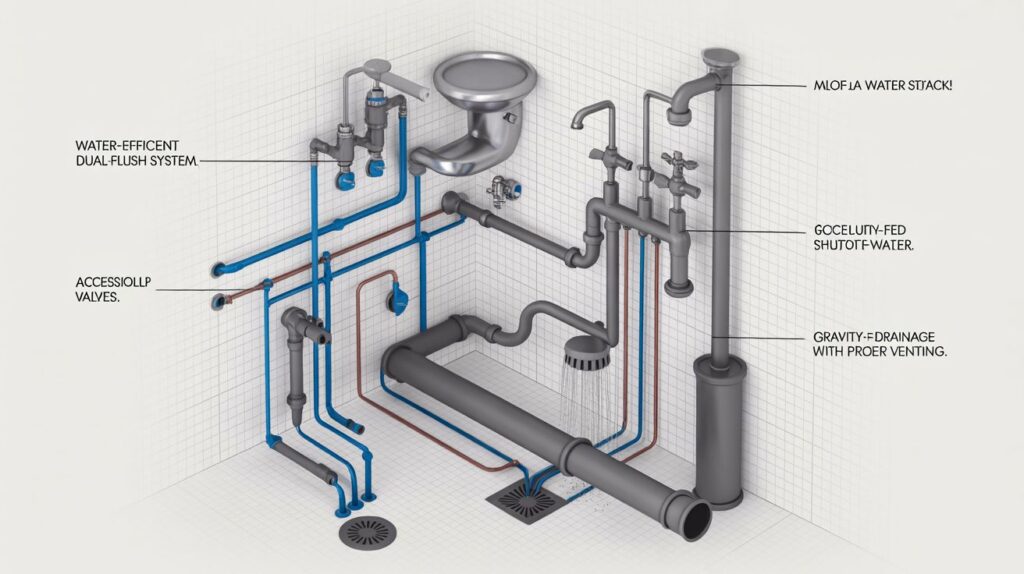I have been, or can be if you click on a link and make a purchase, compensated via a cash payment, gift, or something else of value for writing this post. As an Amazon Associate, I earn from qualifying purchases. Please read my full Affiliate Disclosure for more information.
Plumbing decisions shape your bathroom layout from the ground up, ensuring reliable water pressure, quiet venting, and easy maintenance access. You’ll map drainage and venting early to reduce rework and noise, and place fixtures for natural flow and accessibility. Thoughtful pipe sizing, insulation, and balanced pressure keep hot and cold water steady. Clear service routes and accessible shutoffs prevent hassle. A cohesive design emerges—from compact runs to hidden access, boosting efficiency and style. Curious about how to optimize yours? Keep going.
Key Takeaways
- Plumbing layout drives drainage efficiency, venting placement, and code compliance, impacting overall bathroom performance and durability.
- Fixture placement affects flow, accessibility, and user comfort, shaping usable space and pathways.
- Water pressure and supply routing ensure reliable hot/cold performance and minimize pressure drops between fixtures.
- Clear service access and maintenance routes influence future repairs and long-term ease of ownership.
- Aesthetics and efficiency emerge from cohesive plumbing layouts that minimize clutter and enable water-saving fixtures.
Planning Drainage and Venting Early
Planning drainage and venting early sets the foundation for a smooth bathroom install. You’ll map Drain pipe routing to minimize turns and slopes, ensuring solid gravity flow and easy future access. Think about Vent stack placement to keep odors contained and vents clear of obstructions. By aligning these elements with your fixture layout, you reduce rework and noise inside walls. Prioritize vertical rises and clean progressions between fixtures, avoiding dead zones where clogs start. Confirm code compliance, pipe sizing, and trap distances before drywall goes up. A deliberate plan here saves headaches, time, and budget later on.
Fixture Placement for Flow and Accessibility
Careful fixture placement guides flow and accessibility from the start, ensuring each element works with gravity, clearance, and daily use. You design with intention: position toilet, sink, and shower where paths stay clear and progressions feel natural. Consider fixture types to balance footprint and functionality, choosing compact or wall-mounted options when space is tight, or a freestanding vanity for openness. Align heights for comfort: fixture heights should suit daily tasks, accommodate varied users, and reduce awkward bending. Maintain symmetry and reach, so toe-kicks, grab bars, and door swings don’t collide. Plan clearances, then verify usability through a walkthrough.
Water Pressure, Supply Lines, and Pressure Balancing

Water pressure and supply lines shape how your bathroom functions day to day, so align them with your fixture layout and pressure-balancing strategy from the start. You’ll want consistent flow, minimal pressure drops, and dependable hot water without sudden spikes. Plan your pipe runs to reduce elbows and distance, and choose appropriate diameters for shared fixtures. Pipe insulation helps maintain water temperature, cutting wait times and conserving energy. A balanced system prevents temperature shocks and scalding, especially in showers. Label shutoffs, keep access clear, and verify pressure ratings. Clear coordination between supply lines and fixtures yields comfort, efficiency, and reliable performance.
Clearance, Access, and Maintenance Considerations
Clear access to valves, panels, and service routes keeps maintenance quick and safe, so design around hand radius and clearances from the outset. You’ll prioritize accessible shutoffs, clear space under sinks, and reachable panels for inspections. Plan routes that minimize bending and awkward positions, reducing strain during servicing. Consider pipe insulation to prevent heat loss and condensation, boosting efficiency and reducing touch hazards near hot surfaces. When selecting fixtures, choose models with straightforward connections and serviceability. Fixture selection should also account for access behind walls, avoiding tight squeezes. Thoughtful layout supports longevity, safer maintenance, and a cleaner, calmer bathroom environment.
Aesthetics and Efficiency Through Plumbing Layouts
A well-planned plumbing layout blends beauty with function, aligning pipes and fixtures so they read as a cohesive, unobtrusive feature rather than a set of engineered afterthoughts. You’ll notice how spacing, line of sight, and material choices influence atmosphere and ease of use. By prioritizing compact runs, hidden access, and unified finishes, you create calm visuals and quicker maintenance. The layout can support water conservation without sacrificing style: thoughtfully placed shutoffs, low-profile fixtures, and efficient routing reduce visible clutter. Choose eco friendly fixtures that pair with your aesthetic, enhancing sustainability while delivering reliable comfort and streamlined, modern performance.
Conclusion
You should start with drainage and venting, because early decisions shape every fixture and flow. Plan for smooth paths, accessible clearance, and easy maintenance, so daily use stays comfortable and hassle-free. Tie water pressure and supply lines to balanced, reliable performance, avoiding surprises. Align aesthetics with efficiency, letting layout guide both style and conservation. In short, thoughtful plumbing decisions dominate the bathroom’s usability, beauty, and longevity—make them intentional, precise, and you’ll enjoy a space that works beautifully.

Leave a Reply